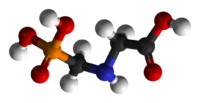
Photo from wikipedia
ABSTRACT Cotton is an important cash crop grown on 2.5% of the world’s arable land in over 100 countries, and has a 31% share of the world’s fibre market. In… Click to show full abstract
ABSTRACT Cotton is an important cash crop grown on 2.5% of the world’s arable land in over 100 countries, and has a 31% share of the world’s fibre market. In Australia, cotton is also a leading crop and contributes around AUD $3 billion to the total agricultural production. Weeds are a major biotic constraint resulting in yield losses of up to 90% and revenue losses of around AUD $100 billion globally and $4 billion to Australian agriculture. Genetically-modified (GM) crops have refashioned the weed management with more dependency on glyphosate. Such overreliance has led to the evolution of 43 glyphosate-resistant (GR) weed populations globally, with 16 species reported from Australia. Such GR weeds along with volunteer glyphosate-tolerant (GT) plants are now decreasing the value of the GM crops and forcing growers to spend more time and effort, and investment in their management. Weed management strategies need to be diversified and integrated with non-chemical methods and alternative herbicides not only to achieve efficient control, but to reduce the rate of evolution of GR weeds. In future, research is needed to improve integrated weed management through development and use of competitive and multiple herbicide-tolerant (HT) crops, organic herbicides, bio-herbicides, RNAi technology and robotics.
Journal Title: Archives of Agronomy and Soil Science
Year Published: 2019
Link to full text (if available)
Share on Social Media: Sign Up to like & get
recommendations!